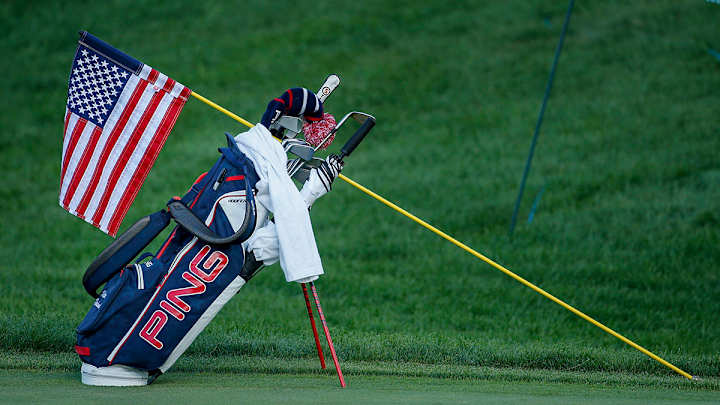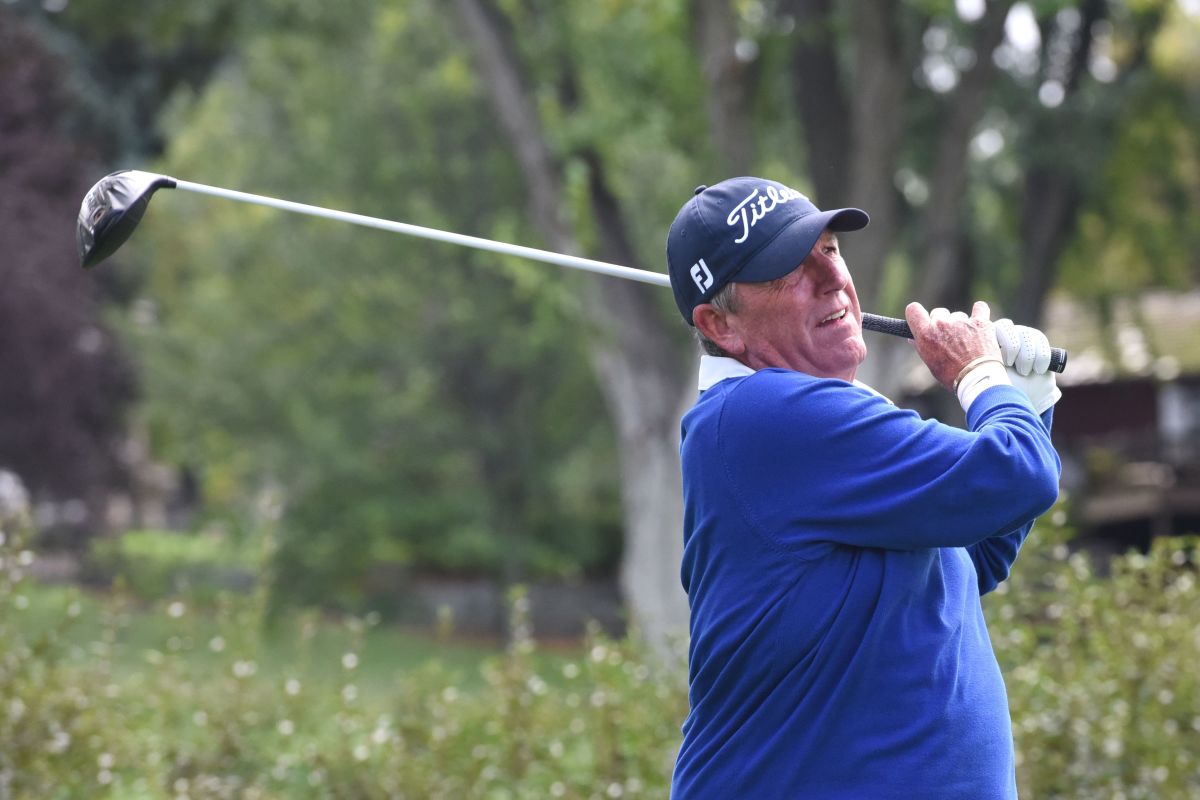Back in St. Louis 20 Years Later, 9/11 Remains a Gut-Wrenching Memory for Players

ST. LOUIS — The morning was a postcard, blues skies above, temperatures in the high 60s, as good as it gets on Sept. 11 in St. Louis. The emerald lawns at Bellerive Country Club were in remarkable shape. Golf fans were pouring through the gates, while many players were still on their way to the 2001 WGC-American Express Championship. The stage was set; the show was about to begin.
Mark Calcavecchia was on the 11th fairway with Tiger Woods, playing Tuesday morning practice holes on the back nine. The clock was just about to strike 8 a.m. local time when a security official alerted the two players about something happening—a plane had slammed into one of the towers at the World Trade Center. The details were sketchy, the implications were uncertain, and so they played on.
They got one hole further when they heard a second plane had hit. Like everyone, they began to realize the circumstances were something more than a tragic accident. Disturbing news kept coming, with each additional hole. The Pentagon was hit, the buildings collapsed, the horror was real.
“We were like, ‘Oh my God,'” Calcavecchia recalled. “Then I'm walking up 18 fairway, we were only going to play nine anyway, and I'm standing next to Tiger Woods. And it dawned on me, I thought, ‘This might not be the smartest thing to do—standing right next to the world's most famous athlete, right?’ Holy cow.
“Then we got in and everybody was just sitting in the locker room with their jaw hanging down, just looking at the TV and just, you know, it was terrible.”
As fate has it, 20 years later, Calcavecchia and others at Bellerive on that day are back in St. Louis, competing in the PGA Tour Champions Ascension Charity Classic at Norwood Hills Country Club.
And as Kenny Perry acknowledged, it’s a bit surreal.
“They always say you remember the place you are when a tragedy happens,” Perry said. “I'll always tell everybody, ‘I was at Bellerive on 9/11, I was on the porch of the clubhouse walking in when it happened.’
“It’s that clear to me. I had just flown in and had gotten my courtesy car and had driven to the club. I was walking up the steps in the clubhouse at Bellerive and the guy said, ‘Did you hear what happened?’ And I said no.
“I just remember they had a TV inside the door there, and I just sat there for hours watching the recap of the planes hitting the towers. Then everything went crazy.”
RELATED: Tiger, 9/11 and Me: A Personal Essay From Bellerive
Bernhard Langer was walking through the clubhouse, on his way to the driving range that Tuesday morning. He never made it.
“I'll never forget,” Langer said. “Somebody inside a room said, ‘Wow, you've got to see this, this can't be right, there's planes crashing into buildings.’ I'm going, ‘No way,’ so I stopped and went in there and watched some on TV what was unfolding.
“It didn't look real, it didn't seem real and we couldn’t … I couldn't grasp my head around how anybody would kill themselves to fly a plane into a building and kill thousands of others, but it was true. And then there was the rumor of more planes and all that, so it was a terrible day.
“I wish I could forget it, but it's ingrained in my brain. As I said, I think it's one of the darkest days and I hope it will never happen again.”
Norwood Hills is located some 3 ½ miles northeast of Bellerive, in a different part of town. But South African Ernie Els doesn’t need reminding of where he was on 9/11, and where he is now.
“I'm staying in the same hotel as in 2001,” Els said. “I came in (Wednesday), went to the same hotel 20 years later, so it's very eerie."
As things unfolded that morning, the response was uncertain. Initially, the PGA Tour announced the tournament would be postponed one day, with 36 holes to be conducted on Friday, followed by standard rounds on Saturday and Sunday. By Wednesday morning, sporting events around the country were canceled, and PGA Tour head Tim Finchem faced a wrenching decision.
Months of preparation had put everything in place, including Woods, who won the Masters earlier that year to complete a “Tiger Slam,” who was the biggest star on the planet, who was playing in St. Louis for the first time. The sponsorship packages were sold, the galleries were bulging, the event was putting St. Louis back on the championship golf map. Moreover, a PGA Tour-sanctioned tournament had not been canceled since 1949, when rain washed out the Colonial NIT.
But the morning after Sept. 11, 2001, it was all irrelevant. The event was canceled. Todd Rhinehart, a Florida resident, had spent the previous 8 ½ months of his life in St. Louis, laying the groundwork at Bellerive. But the tournament director had no trouble understanding an unshakeable rationale for pulling the plug.
“We can sit here in St. Louis, in this beautiful weather, on this beautiful golf course,” Rhinehart said, “while in New York right now, they are using the American Express building for a morgue.”

When the championship stood down, the players faced another difficult situation—how to get home. Air traffic had been grounded throughout the country. Rental cars were like lost treasure.
For Woods, having a sponsorship deal with Buick—which also sponsored the championship—didn’t hurt. He was able to secure his courtesy car and drive 17 hours home to Orlando. Years later, he recalled, “It was a very surreal time for myself on that drive and a lot of reflecting.”
Langer also lucked out. He teamed up with golf writer Tim Rosaforte to share a car to South Florida. One moment, he was headed to the driving range, the next … “We were heading home, and couldn't figure out where the world was going,” he said.
Other players were not as fortunate. Several Europeans had no way of getting home, and could be found on the range at Bellerive days later, trying to stay sharp.
Perry’s home in Franklin, Ky., is 300 miles southeast of St. Louis. Relatively speaking, that’s a short drive. But it’s a long walk. And after he checked out of his hotel, returned his courtesy car and fired blanks on finding a rental, Perry wasn’t sure which he would be doing.
“I'll never forget, I was stuck,” he said. “I didn't have a car to get home to Kentucky, and thank goodness my caddie had driven here. He lives in Denver, but he drove me all the way back to Franklin, Ky. It's not that far from here. But still, four hours would be eight hours for him. Because then he had to head back to Denver.”
As for Calcavecchia, he was among the fortunate few to land a rental car on Wednesday evening. He hopped in his Pontiac Grand Am, put the pedal to the metal and covered the 1,600 miles home to Phoenix in 19 hours.
While the miles flew by, the hours gave Calcavecchia an opportunity to process what had taken place. “I was on my phone a lot,” he said. “But mainly, just listening to music and just still thinking about it.
“I mean, you still see the planes flying into the building and it's just …”
Calcavecchia never finished the thought. Like all of us, he never has.
